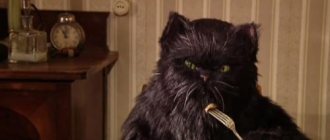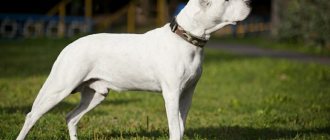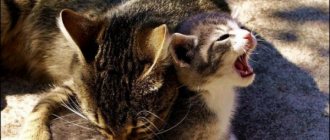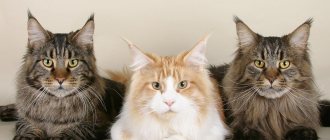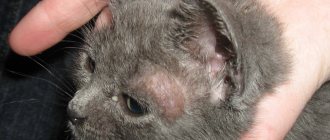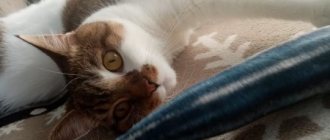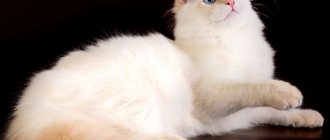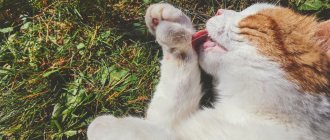Characteristics of the British chinchilla - character and behavior
Speaking about the characteristics of the breed, it’s worth saying right away that the British chinchilla is an aristocrat among cats. She quickly and easily gets used to her owner and his family, feeling like a full-fledged member of society. But at the same time, the cat avoids excessive displays of feelings, preferring to love everyone in silence. In addition, she does not like excessive attention - if you pet your pet too actively or hug him too much, the British chinchilla will get up and go to a quieter place. Because of this, they are perceived as cold and unfriendly animals.
Kittens quickly learn the rules of living in a family if they are clear and well formulated. They will never crap past the litter box, climb onto the bed, or steal food from the table, but to do this, the owner must immediately confront the pet with these facts and be adamant. You should not hope that after the cat has slept on the owner’s pillows several times and has not been punished for it, he will give up this pleasant habit.
It’s nice that even in a small apartment, a Briton will not cause unnecessary problems for the owners. They don’t rush around the rooms like crazy and don’t wake up the owner with howls if at three o’clock in the morning they suddenly want a snack and the cup is empty. Therefore, if you love cats, it will be difficult to find a better pet than the British chinchilla.
Education and training
Chinchillas need to be raised and trained using the same methods as all cats, but taking into account the individual characteristics of each breed. Mandatory skills and abilities that the animal must master by the age of one year:
- the ability to respond to one’s own nickname;
- go to the toilet and sharpen your claws in a strictly designated place;
- observe the sleeping and feeding schedule, do not wake the owner at night;
- sit calmly in the owner's arms;
- adequately perceive the need for transportation: traveling in a carrier bag, traveling by car.
Owners of show pets will also have to work on the technique of displaying the animal at an exhibition. Since both the British, the Persians, and the Scottish have a compact body, in the ring they are not exhibited “stretched” like Orientals, but in a grouped state. Preparation for this action is considered to be the development in the cat of the habit of sitting on the laps and hands of the owner, as well as patiently accepting changes in posture at the insistence of the person.
Persian chinchillas are intelligent and highly intelligent cats, grasping basic cat wisdom on the fly. For example, by 1-1.5 months, kittens go to the litter tray quite carefully. Often, if babies live with their mother or another adult cat, they don’t even need to be taught this skill - the furballs independently copy the behavior of the older pet.
Young and even slightly mature chinchillopers retain a lively interest and curiosity in things they see for the first time, so at first you will have to hide indoor plants, toxic detergents and cleaners, as well as the wires of household appliances from the animal. The breed does not produce any destructive actions - chinchillas do not scratch furniture (provided that there is a normal scratching post in the house), they do not rummage through the owner’s plates, and they do not take away piece by piece a newspaper forgotten by the bed.
At the beginning of socialization, it is important for a kitten in a new home to create a peaceful atmosphere, so try to make less noise in the presence of the baby and warn your household about this. Classes should be carried out taking into account the chinchilla’s biorhythms: in the mornings and afternoons, cats are inactive and prefer to take a nap. And of course, keep in mind that not a single pet is capable of multitasking, so if you decide to practice one command, finish what you started without switching to teaching your furry other useful skills.
Chinchillas from the British and Scottish clans are hampered in their studies by natural shyness and timidity. These comrades are generally frightened by everything new and unknown, so during lessons, talk more with your pet in an even, calm voice. A chinchilla doing dirty tricks is such a rare phenomenon that not every owner of the breed manages to see it. If, nevertheless, the pet is drawn to the “scratchers” or the dining table, influence the animal with its own fears. Suddenly clap your hands or secretly splash water on the furry criminal - then you can only watch how the chinchilla coward quickly runs away from the crime scene, turning into a quiet good boy.
Description of the breed - what does a British chinchilla cat look like?
When choosing a suitable pet, it is advisable to take into account not only the character, but also the external description. On the one hand, this allows you to make sure that this breed will be a good choice. On the other hand, it reduces the risk of acquiring a purebred cat with defects. Therefore, this point should be described in more detail.
Appearance
The head of the British chinchilla is wide, massive and at the same time almost round. The transition of the forehead to the muzzle is clear and pronounced when viewed from the side. The skull is strong and has smooth, rounded contours. The forehead should be convex - a flat one is considered a gross defect. The cheeks are also rounded and full, making the pet’s face look elegant and cute. Wide cheekbones further round the head visually.
The nose is wide, but short and straight. The length is most often average. Strong, well developed chin. The ears are set wide apart and are of medium size. They are wide at the base and gradually taper towards the tips to end in a graceful curve. Large, almost round eyes are set wide. Eye color depends on the main color – we’ll talk about this a little later. But it must be rich.
The body can be either large or medium. The muscles are well developed, the physique is strong. The back is straight. The chest is strong and deep, smoothly flowing into broad shoulders. Body of medium length, stocky. The tail is thick at the very base, but tapers neatly towards the tip. The length of the tail is 70% of the length of the body.
Size
The British Chinchilla has a height at the withers of about 35 cm. And a strong physique gives the cat solidity and confidence.
Weight
Thanks to their powerful build, British chinchillas weigh a lot. Typically, adult cats reach a weight of 5-8 kg, and among sterilized cats living in small apartments, and even eating well, it is not uncommon for an indicator of 10-12 kilograms. Cats are noticeably smaller than cats - they usually weigh only 3-4 kilograms. True, if your pet is sterilized, she will actively gain additional weight and can reach 6-7 kilograms.
Wool
The wool is plush and moderately soft. Not too long, but at the same time longer than short-haired breeds. Pleasant to the touch, with a delicate texture. Doesn't fit tightly to the body. The undercoat is abundant and pronounced. Both too coarse and too soft wool are not allowed - here connoisseurs of the British chinchilla have strict requirements. A long-haired chinchilla is also likely to be rejected at the show.
Colors
Chinchilla color comes in two varieties: tipped and shading. In the first option, the wool is partially colored - the base remains white, and the very tips, about 1/8 of the length, are colored the main color.
Shading or shaded is a little different. The wool is also partially dyed, but more intensely - the hair is dyed about a third of the length.
The breed standard allows for many color options. The main ones include:
- White wool,
- blue (and also blue gold),
- redhead,
- black,
- gray,
- gold (or, as an option, golden - according to the standard marking BRI NY 12),
- silver
But a marbled cat or a representative of the breed with a point color is definitely considered a defect - such colors are not found in purebred British chinchillas.
BRITISH CAT SILVER CHINCHILLA: SNOW-WHITE CATS WITH A VEILE
British silver chinchillas always have a white undercoat, bright colored green eyes, and a “spraying” of the main color tone, which most intensely colors the back, sides, and tail of the animal. The pads of the paws and the mirror of the nose should correspond to the main tone of the color (for example, if the tips of the hairs are black, then the pads of the paws will also be black; the same goes for the blue tone).
Silver cats are more common than golden cats and are more common, so the choice of kittens is not as limited as with golden cats. However, here too it is important to find a good breeder who pays great attention not only to the color itself, but also to the health of the babies.
The British silver chinchilla cat wears a bright snow-white coat, and there should be no yellow spots in the color - it is rejected by experts. Such spots can form as a result of incorrect matings or mistakes by breeders. More often, such spots occur during matings, when one of the parents wears gold in color, and the other wears silver. Thus, low-quality silver is obtained.
British silver chinchilla kittens can only be born to chinchilla parents, and both parents must have green eyes.
Are British Chinchilla cats hypoallergenic or not? How often do they shed?
Cats of this breed shed twice a year - in the off-season, replacing summer coat with winter coat and vice versa. At this time, they need special care - they will have to be combed three to four times a week, or better yet, every day. But even with this there will be a lot of wool. And the rest of the time, molting occurs constantly, although not so intensely.
The British chinchilla is not hypoallergenic. If there are people in the family who suffer from allergies to cat fur, then you definitely shouldn’t get a British chinchilla.
Chinchilla health and diseases
The main problems of Persian chinchillas are uncontrollable lacrimation and susceptibility to colds. The latter phenomenon is directly related to the structural features of the animal’s skull. All chinchillopers have been diagnosed with a slight curvature of the nasal septum, due to which even a slight runny nose is more difficult for them than for other cats.
British and Scottish Straight chinchillas do not have genetic diseases. At the same time, representatives of these families easily catch various infections, the salvation from which will be timely vaccination. Cats are also prone to gaining extra pounds, so when creating a diet, you will have to constantly keep your finger on the pulse.
Scottish Fold chinchillas are not as big as Straights. In particular, Scottish Folds exhibit a genetic disease such as osteochondrodysplasia. The disease is provoked by the gene responsible for the drooping shape of the animal’s ear, so it will not be possible to prevent it even if one wants to.
Is the British Chinchilla a friendly breed?
There is an opinion among some animal lovers that this breed is not very friendly. Allegedly, she does not like affection and tries to stay away from people who often pet her.
Actually this is not true. The British chinchilla, like any other cat, loves affection. She loves to lie on her owner's lap while he affectionately scratches behind the ear.
But at the same time, she has an aristocratic measure of intimacy. When petted, the pet purrs happily. But if you cross a certain line - forcefully hold him on your knees, hold him tightly to you, or press hard while stroking him, the Briton will definitely not tolerate this and will try to sneak away. Therefore, when getting a cat of this breed, be prepared for the fact that she will respect you if you are ready to treat her with respect.
Kittens
British breed babies do not have clearly defined coat and eye colors. In childhood, the fur of a golden chinchilla cat can be distinguished. The animal is finally formed by the age of 1.5 years. In an adult animal, the color of the fur and eyes is visible, and it no longer changes with age.
For kittens to develop normally, food must be age appropriate. It is better to use ready-made dry and wet food. Kittens should not be fed cow's milk. For them, it is better to use goat’s milk or diluted in a ratio of 1:3 (where 3 parts are cow’s milk).
Attitude towards children
Almost always, British chinchillas have a peaceful relationship with children. They are smart enough to forgive human kittens some mistakes. Therefore, if they try to pull the tail or lift it, awkwardly grabbing the stomach, the cat will probably not use its teeth or claws. Instead, he will hastily, but with a certain grace, retreat to a place that is inaccessible to children. The main thing is to teach the latter that the pet has a certain place where he can be alone - for example, a box or a cat house. Now, if an overly intrusive child tries to pull the cat out of the shelter, which she is accustomed to consider inviolable, there is already a possibility of conflict. But in general, the British chinchilla is not at all predisposed to aggression.
Origin story
The chinchilla breed originates in Great Britain. It was there that the first Persian cat with an unusual color was born - Sheena. Breeders paid attention to the baby in 1882, which was the beginning of breeding work.
Sheena's owner chose a cat with a suitable color for her pet. From these matings two litters of silver kittens were born. They were exhibited quite successfully, but did not leave offspring (at least there is no data on this). The first officially registered chinchilla cat appeared as a result of crossing the Betty cat with a smoky male.
The selection continued. Due to the small number of individuals of this variety, the descendants of the first chinchilla began to be crossed with purebred British. To fix the bright green color of the eyes, tabby blood was added. At first, the kittens were born dark, they looked more like blue-gray British cats. Over time, breeders managed to achieve a pearly sheen.
Initially, this color was considered an advantage of exclusively long-haired cats with pronounced Persian roots. By the 1970s, this coat color began to be taken into account in British and some other cat breeds.
Experts are still arguing about whether chinchillas should be considered a separate breed or a subspecies of Persians. Be that as it may, this color was the first to be specially selected. He is assigned by breeders, but without qualifications.
Attitude towards other animals
How relationships with other pets will develop depends solely on their behavior. The British chinchilla does not have a tendency to conflict. However, this aristocrat will not tolerate infringement of his rights. Relationships with large dogs are friendly. A cat and a dog can become friends - sleep together, eat from the same bowl. With small dogs that bark a lot and often try to assert themselves at the expense of others, relationships will most likely be strained, and there is even the possibility of conflicts.
British chinchillas are reserved with cats, but, as a rule, they do not show excessive affection. Relations are calm, even, but not too friendly. Although, if the neighbors try to dominate and oppress a native of Britain, things may end in a fight.
British chinchillas will not make friends with small rodents, such as rats, mice or hamsters - they are perceived exclusively as potential prey. Therefore, it is better not to leave your pets alone, at least if the lives of small animals are not protected by the glass of the aquarium or the metal bars of the cage.
Care
Chinchillas are unpretentious in maintenance, but require care to maintain their external splendor. Especially if you are going to shine with your pet at exhibitions.
Wool
The main difficulty in keeping a chinchilla is the cat's fur. Caring for it involves the following manipulations:
- brush your cat at least twice a week (preferably every day). Run a wide-toothed comb through the fur, then a fine-toothed comb to remove any loose hairs. After this, comb the animal with a brush with stiff bristles, first along the hairline, then against it;
- if tangles do form, they need to be carefully cut off;
- Don't forget to comb the areas between your toes. The chinchilla has a short tongue, so it is difficult for her to care for the skin;
- You need to bathe your cat regularly, using a special shampoo. Make sure that foam does not get into your eyes and ears. After washing, the animal should be dried with a hairdryer and wrapped in a warm towel.
Before the exhibition, a light chinchilla is washed 5-7 days in advance, and before the show it is sprinkled with talcum powder or special powder.
A dark-colored cat is rinsed with cherry laurel water, and the fur is “fluffed” on the eve of the event.
A properly selected diet plays a very important role in caring for a chinchilla.
Ears, eyes and claws
A chinchilla needs to be taught hygiene procedures from early childhood:
- the eyes of these cats tend to water, so they should be wiped every day with a soft cloth soaked in warm boiled water or a weak chamomile infusion;
- Inspect your ears regularly and clean them once a week with a cotton pad;
- claws should be trimmed once a month if your pet has a special “scratching post” from a pet store. If there is no such device, the procedure will have to be carried out once every two weeks.
- It is very important to teach the kitten to brush its teeth; this should be done 2-3 times a week, since chinchillas’ teeth are susceptible to caries. Dry food helps get rid of the formation of stones and plaque.
Nutrition
Owners of any cat have a choice: feed the animal with industrial food or natural food. If you decide to go with the first option, keep in mind that chinchillas are not very active, are quite large and prone to obesity. The food needs to be balanced, enriched with vitamins and microelements (especially calcium and biotin), but low in calories.
Do not choose food with a high content of vitamin A - this will cause the white coat to turn yellow. Premium and super-premium products are suitable for long-haired cats.
Never feed your animal food from the supermarket!
Recommended brands:
- Pro Plan;
- Eukanuba;
- Hills;
- Royal Canin.
Before the exhibition, to restore the strength of the torso, you can give kitten food with a high content of proteins and fats for several days.
Attention! You can’t suddenly change the brand of food - the chinchilla may have an allergic reaction in the form of ear itching!
If you decide to cook for your pet yourself, you need to include in your cat’s diet:
- boiled chicken without skin;
- beef;
- cottage cheese;
- rabbit meat;
- ground bones;
- eggs (no more than twice a week);
- offal;
- dairy products;
- boiled sea fish without bones and skin.
You should not give your cat:
- river fish;
- sausage;
- milk;
- smoked meats;
- fatty and fried foods from the table.
Due to the specific structure of the muzzle, chinchillas' food should not be hard. Meat and offal should be given cut into small pieces, after keeping them in the freezer for five days to prevent the cat from becoming infected with helminths.
It is better not to combine natural feeding of an adult animal with ready-made food. For example, to feed dry food in the morning and home-cooked food in the evening, it’s worth stopping at just one thing.
Walking your pet
The chinchilla doesn't need regular walking, but it won't hurt. If the cat lives in a private house, you can let it go for a walk in the yard, after first making sure that there are no objects dangerous to the animal.
A cat living in a city apartment must be taken outside on a harness. Don't forget to also wear a pest collar.
Playfulness
What British chinchillas love is to play. Seeing a thread with a bow at the end or another toy, they instantly forget about their solidity, sophistication and aristocratic manners. There is only a cat and his toy. Even older animals, not to mention kittens, are ready to chase a target for a long time, catching it, throwing it, temporarily releasing it and attacking again. Playing together will give a lot of pleasure to both the owner and the pet.
But this can also be called a disadvantage. You need to regularly spend at least a little time playing with your cat. Otherwise, the relationship may deteriorate - the cat will no longer perceive the owner as a close friend. And lack of mobility often leads to excess weight gain, which affects the well-being and health of the pet.
Therefore, it is best to get British chinchillas for large families with many children who are ready to regularly find time to play with their favorite pet.
Castration and sterilization
If the animal will not participate in mating, and the owner does not want to produce offspring, then it is worth doing the procedure of sterilization or castration. It will protect the pet’s health and prevent accidental mating. It is recommended to castrate and sterilize individuals who were born in marriage or have genetic diseases.
The operation is allowed to be carried out at 8-10 months, when the animal’s body is fully formed. Before the operation, it is important to examine the British person, since deviations in health can lead to complications.
Caring for your pet after surgery
After surgery, your pet will need special care that will reduce the risk of complications.
For several days after surgery it is recommended:
- limit the animal's mobility;
- provide comfort;
- do not frighten or torment your pet;
- do not feed for 10 hours after anesthesia;
- put on a special device to maintain the seams;
- treat seams once a day for 14 days.
If a Briton feels unwell, the stitches begin to get wet, the temperature rises, etc., then he must be taken to the clinic immediately.
How to cope with loneliness
An important advantage of the breed is the ability to enjoy not only a large company, but also loneliness. Yes, if you leave your pet alone for the whole day, you don’t have to worry that he will tear the upholstery on the sofa, knock over a flower and turn important documents into confetti. The British chinchilla calmly accepts loneliness and will take advantage of the free time to clean itself up, get a good night's sleep, sit on the window, calmly watching what is happening in the yard. In a word, an ideal pet for people with irregular work schedules.
WHAT IS THE WEAKNESS IN THE HEALTH OF BRITISH CATS?
Each of us probably understands that any animal, any breed, like the British one, has weaknesses in terms of health. Our goal is to prevent and prevent diseases. Forewarned is forearmed. If everyone is aware of the possible risks, we can prolong a pet's life and improve its quality. After all, a healthy animal means less stress and anxiety for every family member.
DISEASES OF BRITISH CAT BREEDS AND THEIR SYMPTOMS
Let's divide them into several categories:
- genetic
- acquired
GENETIC DISEASES OF THE BRITISH
Genetic diseases are transmitted exclusively from the parents to the kitten, cannot be suppressed, and will be inherited in the future. Since any gene consists of two alleles, the disease also carries dominant and recessive genes. An animal may not be sick, but still be a carrier. Genetic diseases are currently under strict control among felinologists. As soon as a genetic disease is detected, the producer is immediately removed from breeding, and his descendants must be tested for the absence of this disease.
The most common genetic diseases of British cats:
- Polycystic kidney disease (PKD, Polycystic Kidney Disease);
- Cardiomyopathy
Polycystic disease is a genetic kidney disease in which cysts form .
Important! If the kitten's parents are tested and have a negative test for these diseases, then the kitten will be healthy.
Cardiomyopathy - heart disease (Hypertrophic cardiomyopathy - HCM, Dilated cardiomyopathy - DCM). In order to prevent cardiomyopathy, an ultrasound of the heart must be done every year, starting from 12 months. This disease cannot be cured. If HA is not detected in an animal before the age of 8, there is no need to worry about its appearance in the future.
These are the most common genetic diseases in British cats. We will not consider everything, because... they have isolated cases all over the world.
PURCHASED: WHAT ARE BRITISH CATS MOST COMMONLY SICK?
The British breed is a strong breed, characterized by fairly good health and immunity. But be that as it may, let’s consider those diseases of British cats that can be acquired during life.
OBESITY
As we know, cats of this breed have a large, massive build. Often, not only castrated individuals, but also those who actively participate in breeding suffer from obesity (not to be confused with a massive muscular physique!). As a result, excess weight leads to pathological diseases of the heart and liver. Therefore, it is recommended to strictly control portions and create a diet. Balanced diet, no need to cut down on fats, because... Fats are also the building material of the body. Therefore, there are series of feeds for each breed, taking into account all the features they are developed.
Attention! Do not confuse excess weight with a saggy belly; in this breed, it is mainly a noma.
Don’t forget to consult with veterinarians, because you should contact them not only in cases of illness. A knowledgeable specialist will also give you advice on nutrition. Also, the breeder from the nursery where you adopted the cat will always be happy to come to your aid; many years of experience are worth a lot.
Conclusion: to prevent obesity, it is necessary to monitor the pet’s nutrition, provide an active lifestyle for the cat, carry out vaccinations during the period, and periodically undergo tests at the veterinarian.
URILOTHIS DISEASE IN BRITISH CATS
Urolithiasis is a fairly common occurrence in cats. What does urolithiasis mean? – a disease characterized by the formation of sand and stones in the bladder and kidneys. The reason for the development is heredity, poor nutrition, untimely care, poor water quality, castration, infectious diseases of the reproductive system.
PREVENTION OF URILOSIS IN THE BRITISH
What to do to prevent this disease:
- Proper, balanced nutrition (in no case should you give smoked, salted, whiskey/friskas/kitiket, etc.);
- Be sure to give only clean filtered or bottled water;
- After castration, carry out prophylaxis. For example, the animal should eat food for neutered cats.
- Do not allow your pet to rest on cold surfaces (tiles, washbasin, windowsill with an open window, etc.)
- Ultrasound and examination by a veterinarian (recommended once a year).
Indeed, in order to make sure that a British cat does not have urolithiasis, it is enough to do an examination and ultrasound once a year (with an ultrasound, the cat is shaved or cut). After all, this disease is “silent”, develops without symptoms, and the first signs can only be seen during an exacerbation.
The first signs are that licking of the genitals has become more frequent, we hear meowing when the animal urinates, anxiety, and blood in the urine.
If urolithiasis is detected and suspected, it is necessary to collect urine for analysis. This is also part of the diagnosis.
Now there is a special device for collecting urine. After all, it’s harder to do than to say. A urine collection kit can be purchased at pet stores and veterinary clinics. The set consists of granules in the form of balls that do not absorb moisture, and a pipette for collecting urine. Pour the granules into a clean tray, wait for the cat to urinate, and use a pipette to collect the urine into the container.
EYE DISEASES IN BRITISH CATS
Eye diseases occur in British cats, just like in any other cat. If you observe slight tear discharge from the eyes, do not immediately panic. Representatives of the British breed have narrowed tear ducts due to the special shape of the skull. That's why they suffer from tearfulness.
What symptoms indicate it's time to see a veterinarian?
Your pet has:
- swollen red eyes;
- discharge from the eyes, pus;
- eyelashes fall out;
- one of the pupils does not react to light;
- the shape of the eyes is incorrect;
- cloudy cornea;
- any other symptoms that are alarming.
Common infectious and bacterial diseases are blephatitis and conjunctivitis.
Blephatitis is inflammation of the edges of the eyelid. It may also be the result of an allergic reaction.
Conjunctivitis is an inflammatory eye disease. Easily treated with antibiotics.
Entropion is a neurological or genetic disorder that can be treated with surgery. It’s a simple deviation, it heals quite quickly, and then the cat doesn’t feel any discomfort.
Ptosis is a disease in which the upper eyelid involuntarily droops. The reasons are the same as with entropion of the eyelid, associated with nerve endings.
Keratitis is clouding of the cornea.
BRITISH DENTAL DISEASES
Another tendency of the British breed is tartar. Keep an eye on your cat's mouth and remove tartar if necessary. It is recommended to carry out cleaning once every 2-3 years, sometimes more often.
There are some other symptoms of dental disease that may cause symptoms:
- tooth loss;
- change in color (yellowness, dark spots);
- and etc.
In this case, you should immediately contact your veterinarian. This is likely the result of a chronic illness or other serious illness in your pet. You may have to remove teeth or seriously treat them. Such complications are also possible due to malocclusion.
HELMINTHS AND PROTOZES IN BRITISH CATS
Like all cats, British cats are not immune to parasites - helminths and protozoa. Therefore, do not forget to deworm* every 3-4 months, also before vaccination (recommended 10 days before vaccination).
deworming* - driving away worms.
ECTOPARASITES
During the spring-summer period, ectoparasites - fleas and ticks - become more active. Prevention is recommended for all cats, even completely domestic ones, because, for example, we can bring them on clothes and shoes.
Now there are many means for protection: sprays, shampoos, drops on the withers, etc. At your own discretion, choose the best for your pet.
Please note that British people are not allowed to wear collars! They have a very soft undercoat, which is easy to damage (the fur comes out and a bald rim can form), the skin is very delicate. In addition, such collars are very toxic and can cause poisoning.
Potential Health Problems
The health of the representatives of the breed is excellent - many decades of selection have not been in vain, experts tried to select the strongest and healthiest animals for breeding.
In fact, the only health problem is a predisposition to allergies. Therefore, only proven and high-quality food should be given, and new components should be introduced into the diet gradually, carefully monitoring the animal’s well-being. Spoiled or unsuitable food affects the entire gastrointestinal tract. In the most advanced cases, this leads to liver disease and diabetes.
In some cases, although less frequently, problems with the eyes (retinal atrophy) and the cardiovascular system occur. Therefore, it is important to ensure that older cats do not run around a lot - they need enough rest and it is not advisable to disturb them at this time.
Obesity may also occur. But only in cases where the owner feeds the pet uncontrollably and with inappropriate food. Gaining excess weight is dangerous; it often leads to the development of a whole range of serious diseases that shorten life. So, it is important to ensure that the cat eats not only high-quality food, but also in sufficient and not excessive quantities. Then the pet will live a long life and even in old age will be cheerful, active and cheerful.
Choosing a kitten
There are quite a lot of advertisements from private owners on websites and electronic boards with offers to choose a chinchilla cat. They offer to buy a British shorthair chinchilla cat for almost pennies: from 1-2 thousand rubles. Usually for this price you get a pet without documents or pedigree.
The buyer cannot be sure of the baby’s excellent health and does not know in what conditions the kitten grew up before the sale. Unscrupulous sellers breed incompatible samples and do not monitor the breed standard. All this leads to disastrous consequences: illness and death of animals.
At a young age, it is not clear what color a cat will have. The seller will try to assure the presence of this or that breed, and on an older ward it will be difficult to see the supposed promised signs of the animal’s standard. The formation of the animal is completed by 1 year and 6 months of life.
Therefore, it is necessary to contact nurseries and clubs, experienced breeders. Advantages of a kitten purchased from a nursery:
- a metric is provided;
- you can see the baby’s parents: in the nursery or from a photograph, evaluate their appearance and behavior;
- the animal will receive all vaccinations strictly according to age;
- the pet will be treated for helminths;
- the baby is trained to the tray;
- the baby is trained in hygiene skills;
British chinchillas quickly get used to going to the toilet in a designated place.
The price of a kitten from an experienced breeder consists of the cost of caring for the animal, purchasing medications and household products. Owners travel abroad for some representatives of the breed: travel plus hotel accommodation require considerable expenses. Participation in exhibitions and mating, selection of a partner for crossing - all this involves costs, sometimes not only material, but also emotional. Every baby is loved and the fate of every member of the nursery worries the owner.
At what age is it better to adopt a kitten?
Before 2 months, professional clubs do not offer kittens for sale. Until this time, the baby should be with the mother. The best food for a newborn kitten is cat's milk. A baby who was taken away from a cat prematurely is not psychologically ready for independent life. Nursery staff jealously monitor the date of the expected departure of the ward to a new habitat. To prevent painful situations, it is unacceptable to take animals away immediately after birth: this will lead to the death of the pet.
Kittens up to one year old are offered at the maximum price. In Moscow, a baby British golden chinchilla can be seen at a price of 25 thousand rubles and more. Some pets are considered up to 70 thousand rubles.
It is not difficult to find a silver British chinchilla kitty in a nursery at a cost of 25-35 thousand rubles. Adult cats that do not participate in exhibitions due to age and have completed their breeding career are offered for a symbolic amount, sometimes in the region of one thousand or two thousand rubles. But it will be a well-groomed, vaccinated, healthy animal.
Cost of kittens
The price for a pet-class kitten will be 5-10 thousand rubles. The standard price for a breed-class cat varies between 20-30 thousand rubles. But if you dream of owning an elite show-class British dog, capable of taking first places at exhibitions and whose kittens will be lined up with connoisseurs, then the price will range from 50 to 100 thousand rubles. The specific amount depends on which nursery you will buy it from and how famous and titled its parents are.
SMALL REVISIONS
When it comes to cat health and thinking ahead, we cannot ignore the topic of blood type.
Today there are three types of blood groups:
- A (dominant);
- AB (transitional, extremely rare);
- B (recessive).
Often, ordinary veterinarians and “therapists” don’t even know about this, so you should go to breeders and genetic centers that conduct this kind of examination.
Why do you need to know your cat's blood type? If your pet needs:
- blood transfusion (may be needed spontaneously). Your city may not have such surveys or they may take a lot of time. In this case, there is a high probability of losing the animal.
- participate in breeding. For example, if a cat has blood type B, and a cat has blood type A, then all the offspring will die (at best, their tails will dry out). As a result of a conflict between these blood groups, born kittens, feeding on mother's milk, die after 2-3 days. Reason: the walls of the intestines and stomach of kittens in newborn age are usually very vulnerable. With mother's colostrum, kittens receive useful substances, but in this case, antibodies kill babies.
British chinchilla nurseries
It is reasonable to adopt a purebred cat from a nursery. In Russia, the British chinchilla is a popular breed and there are many nurseries breeding them. Here are some of them:
- in Moscow: An Marion, Raylis, AppleWood;
- in St. Petersburg: Muslin Cats;
- in Nizhny Novgorod: Emirrian cattery;
- in Yekaterinburg: Silver Shine.
Of course, this is not a complete list of nurseries in Russia. Surely every animal lover can easily find a suitable one near the place where he lives.
GALLERY OF PHOTO BRITISH CHINCHILLAS: BRITISH CATS, CATS, KITTENS SILVER AND GOLDEN CHINCHILLAS
The gallery presents British chinchillas:
- photos of silver British cats, cats, kittens;
- Photos of golden British cats, cats, kittens.
All British chinchillas meet the standard and have the correct color.
| In our cattery you can “buy a real British kitten.” We have many different colors, we will help you choose and answer all your questions! |
Need for care
When getting a British chinchilla, it is important to remember that these cats love an active lifestyle. Therefore, it is advisable to walk them at least once or twice a week. To do this, you should use a harness with a roulette leash. They are smart enough not to run away from their owner. But if the cat is scared, it may climb a tree, get hit by a car, or run away.
Don't forget about regular brushing. And although these cats do not have a tendency to form tangles, you will have to comb your pet at least once or twice a week - without this, hair will be everywhere.
We must not forget about regular care. Check and clean your ears and teeth every week. Monitor the condition of the claws - if your pet does not have a scratching post on which he can grind his claws, then they will have to be trimmed once or twice a month.
Finally, it is advisable to bathe the cat approximately once every two months, using a special shampoo that gives the coat a beautiful shine and volume.
How to choose a kitten
- Kittens of corpulent breeds such as British and Scottish cats grow very unevenly. Accordingly, when going to the nursery, calmly accept the fact that two-month-old babies look extremely cute, but six-month-old teenagers have a very unsightly appearance.
- When buying a Scottish Fold chinchilla, conduct a thorough inspection of its limbs. If a kitten has too short legs and a tail, these are signs of impending osteochondrodysplasia.
- Many chinchilla colors are unstable and can change the saturation of the tone, so if you are afraid to miss, choose cats over the age of 1 year.
- Be sure to meet the kittens' mother. If the breeder stubbornly hides the female breeder, this is a reason not to conclude a deal. You should also not take babies who, for some reason, were raised not by the cat, but by the breeder himself - kittens that did not feed on mother's milk in the first month of life have weak immunity and run the risk of contracting an infectious disease.
- Assess the condition of the animal's coat. A purebred chinchilla should not have bald spots or areas with sparse hair.
Maintenance cost
As we have already found out, the cost of a purebred kitten is high. But after the purchase, the expenses do not end at all. The cat needs to be provided with suitable care. In this case, she will look and feel healthy and live a happy and long life. There are no trifles here and cannot be. Therefore, let's study the main expense items.
Nutrition
The main and most important expense item is the purchase of feed. The owner himself must decide what he will feed the pet - dry food or natural food. Both options are good. The first one saves time, and the second one saves money. However, when feeding dry food, you need to make sure that the cat always has access to fresh, clean water. Otherwise, there is a risk that she will become dehydrated, and this is a direct path to kidney disease.
You need to approach the choice of food responsibly. Cheap food made mainly from soy products should never be used. A cat is a predator that must receive animal proteins, not plant proteins, which are poorly digested. Therefore, make sure that the food contains at least 40% natural proteins (meat, fish, offal), or more. The cost of quality feed starts from 500-700 rubles per kilogram. The approximate portion for an adult is 12 grams per kilogram of live weight. Therefore, with a weight of 3-8 kilograms per month, you will have to spend about 500-2000 rubles on feeding your pet.
When choosing food for kittens, it is important to ensure that the kitten can chew the kibble normally. If they are too large, then the tiny jaws will not be able to handle them and the pet will be constantly hungry. It is advisable to take special food for kittens.
Some owners prefer to feed their pet natural food. Vegetables and fruits are practically not needed, but if your pet likes to feast on them, then you can give them. The main thing is that they make up no more than 40% of the diet, and preferably less. The main diet consists exclusively of animal products - after all, a cat is a predator by nature. Your best bet is lean meat such as beef, poultry and rabbit. Three to four times a week you can give sea fish, after removing large bones. If there is none, it can be replaced with river water, but carefully boiled so that the cat does not become infected with worms. A third of the diet should be diversified with offal products - heart, kidneys and liver. On the one hand, this makes food cheaper. On the other hand, offal contains many microelements and vitamins that are not found in meat. Therefore, they are needed for a balanced diet.
But you need to be careful with milk. Yes, kittens eat it with pleasure. In adult cats and kittens, it can cause stomach upset. To prevent this from happening, you should replace milk with low-fat kefir or fermented baked milk. British chinchillas eat them with pleasure, receiving calcium and other necessary substances.
Veterinary
It was said above that British chinchillas get sick relatively rarely. But this does not mean that visits to the veterinarian can be ignored. No, any disease is easier to cure in the initial stages than when it is advanced. Or better yet, prevent it.
Therefore, you need to visit the veterinary clinic regularly: annually for young and adult cats and twice a year for older cats. The initial visit costs approximately 500-600 rubles, and subsequent ones - 300-400.
If a disease is detected, the cost of treatment varies greatly - there are many nuances that will have to be dealt with depending on the situation.
Exhibitions
Cat shows are rarely free. There is almost always a certain participation fee. And its size varies - from several hundred rubles to several thousand. This depends on several factors: the prestige of the club, the fame of the invited judges, prizes, etc.
In addition, you will have to spend money on grooming, a handler, travel and accommodation (if the exhibition is held in another city).
Nutrition
To keep your pet's coat in good condition, the British chinchilla needs special nutrition. The best option is dry food. It is chosen depending on the age and gender of the pet.
Castrated and sterilized animals require special food. Manufacturers produce food for such animals. If feeding is homemade, it should be low-calorie, since processed animals are famous for their large appetites and are prone to becoming overweight. In addition, their hormonal levels are disrupted and this is taken into account when feeding.
If you plan to use homemade food, the chinchilla’s menu should include cereals, meat, fish (sea, as river fish can have parasites), and vegetables. Raw meat should not be given to cats. The product may contain worm eggs, and the animal will become infected with parasites.
A Briton should have constant access to clean water and his dishes should always be clean.
To keep their fur in good condition, cats are given eggs. Natural proteins and protein strengthen the roots, hairs do not grow so abundantly. With this diet, the fur of a silver or golden chinchilla becomes shiny and denser. Quail eggs are preferable to chicken eggs. But not everyone can afford to feed their cat quail eggs.
Pros and cons of the breed
One of the main advantages that catches your eye at first glance is the coat. Thanks to him, the cat looks not just fluffy, but even plush. And the color is beautiful - we managed to get it thanks to long-term selection. But he made the breed popular all over the world.
An additional plus is a balanced, calm character. The British chinchilla is suitable for keeping both in a spacious private house in the village and in a cramped city apartment. And animals experience long-term loneliness calmly - they sleep, lick themselves, play, eat, instead of getting bored and acting up. Even if there is a multi-day move ahead, the British chinchilla will feel calm in a carrier bag or cage, while other representatives of the cat tribe will probably fall into hysterics.
The breed has only one drawback - its difficult character. These cats are not deprived of a love of freedom. No matter how the owner persuades and forces the pet to do something that it does not want, it will not cope with the task. Therefore, it is important from the first days after the appearance of a kitten in the house to begin raising it correctly.
Where does the British Golden Chinchilla live?
Photo: British Golden Chinchilla cat
As representatives of an aristocratic breed, cats need special living conditions. Before you get such a cat, you should think about whether you can provide him with the proper living conditions. A prerequisite for a comfortable existence is cleanliness and order. Another important criterion is the optimal room temperature. These cats are not intended to be kept in outdoor conditions. They cannot tolerate cold, so the room temperature must be at least 22 degrees.
Unlike other cats, they tolerate loneliness well, and even love it. The less people and attention there are for the Scots, the more comfortable they will feel. However, they require attention and participation from the owner in their life. Coming home from work, the owner must take pity on his pet and pay attention to it. Be sure to keep your cat's ears clean. This is the weak point of representatives of this breed. Often, due to untimely cleansing, cats develop infection, suppuration, and infectious processes.
Such an aristocratic animal definitely requires personal space. In this regard, it is necessary to take care of the arrangement of the “house”. It is best if it is located in a secluded place, hidden from prying eyes. It cannot be said that golden chinchillas are demanding in terms of living conditions and care. However, there are some guidelines that you need to follow.
Animals' eyes should be wiped with a cotton pad moistened with boiled water. A weak solution of chamomile can be used as a solution. Cats need to brush their teeth once a day. Teeth cleaning is carried out with special hygiene products that are sold in veterinary pharmacies. Animals' nails should be trimmed at least once a month.
History of the breed
This breed appeared in 1882. To do this, breeders had to cross Persian and British cats, thereby obtaining kittens with amazing coat color.
When silver kittens became commonplace, breeders decided to breed cats of new colors: shaded silver and golden. At the same time, another variety of British chinchillas was bred - long-haired.
The breed gained enormous popularity when Princess Victoria herself noticed it. By placing several cats in the royal palace, she made keeping British chinchillas fashionable and prestigious. It is not surprising that many people not only in England, but throughout Europe after that tried to get themselves such pets.
Description
British cats have a round muzzle and wide cheekbones. The animals have a rather large body. The eyes are large, expressive, of various shades of green. The nose is slightly flattened. The ears are small, the fur is thick and long. The neck is short. The limbs appear short due to the long fur on the belly. The pads are powerful and round.
Chinchilla cats tend to be overweight and are easy to overfeed. British chinchillas can hardly be called elegant and graceful. It's more like a cute little bundle of warmth and beauty.
Males are larger than females, the weight of an adult cat reaches 7 kg. Cats weigh around 4 kg. After castration, males gain weight and can weigh 10 kg or more. Females after sterilization weigh up to 8 kg.
The average life expectancy of a British chinchilla is 10-15 years. With good care, a pet lives 20 years.
Photo
History of origin
Back in the 19th century, cat breeders tried to get an unusual coat color by crossing Persian cats with British ones. Subsequently, they began to introduce the tabby cat, which is famous for its green eyes. But the color still didn’t turn out as planned, so the breeders introduced Persian cats into crossbreeding, which led to the development of such a chic color of British chinchillas.
Now British, Persian and Burmese cats have chinchilla color
Owner reviews
To get a complete picture of the breed, it would be a good idea to collect reviews from owners who are well aware of the advantages and disadvantages of British chinchillas.
Many of them note their excellent appearance. Not every breed can boast of such attractiveness. Plus, they look incredibly cute. The owners also note good health - with proper care, they rarely need to seek help from a veterinarian. A calm character and peaceful attitude towards children are perceived as additional advantages to the above.
True, speaking about the positive features of the breed, many also note the high cost - after all, this is an important disadvantage. And not every breeder likes a wayward character - many prefer more docile and obedient pets.
Concluding the article, we can say with confidence that the British chinchilla is an excellent breed. Willful and intelligent, friendly and beautiful, such a cat will become a faithful friend and decoration of any home.
Health
British chinchillas are distinguished by good health. These are hardy animals that are not afraid of frost and wind. Warm and thick wool reliably protects pets from the vagaries of the weather. But it’s better not to take your fluffy for a walk in the rain or slush.
Like all cats, chinchillas suffer from kidney disease. Bring your pet to the veterinarian periodically to detect pathology at an early stage.
The British have watery eyes, and this is taken into account when purchasing a kitten, since the eyes will require care.
Reviews
I was given a golden British chinchilla for my birthday. This is probably the best gift of my entire life, my miracle. She's just like a toy, plush fur. And her chic golden color simply does not allow you to take your eyes off her. She has already become a member of our family. I feed her Royal Canin. She likes. It is clear that the food has arrived. Her coat is shiny and she herself is very active. You really get fat quickly.
Kate
Our neighbor upstairs has a chinchilla cat. They bought it at an exhibition somewhere. I think this breed of chinchilla cat is called the British Silver. The neighbor doesn’t let him outside because we have a lot of ordinary cats in our yard, she’s afraid of ruining his pedigree. Sometimes the children and I go to see it. It's just lovely. His silver fur and very bright eyes make him look like a doll. It seems that he is not real. He meows very rarely, such a calm, beautiful cat. Of course, we won’t buy one for ourselves, because I’m afraid the children will squeeze it. And so, of course, we are all in love with our neighbor Patrick.
Marina
I never knew before that there were such beautiful cats. When my husband showed me a golden chinchilla cat on the Internet and asked if I wanted one, I replied that, of course, yes. We went to look for one of these in nurseries, but it turned out to be not so easy. Such a handsome golden man costs a lot of money. He is easy to care for, we feed him special food, sometimes we give him cottage cheese and fish. Now she’s thinking about buying another silver chinchilla, but I’m afraid that they might quarrel.
Zoya
We have had a silver chinchilla of the British breed living with us for four years now. We named him Sema. All this time we lived in an apartment and did not let him go outside, and last year we moved into a house. We tried to walk our handsome silver guy outside. It was just a huge stress for him. He pressed himself to the ground and lay there almost all the time, tucking his ears and tail, constantly looking around. After this incident, he lived only in one room, and later began to go out. Now he walks perfectly on the street, he doesn’t go out of the gate. In general, the silver chinchilla cat is very domestic and calm. She sleeps or rests most of the time. But ours sometimes runs around the house like crazy.
Kolya
There is a woman living in our building who bought a golden chinchilla cat at an exhibition.
She took a very responsible approach to choosing a pet and always wanted to participate in exhibitions with this cat. When she brought it home, we asked to see it. I have never seen such beautiful cats in my life. The cat is not just golden, it is some kind of copper-peach-gold. Each of his hairs is stretched with a gradient of color. And to the touch it is just an incredibly soft plush toy. Now the cat is 2 years old and his owner takes him to various exhibitions, where he sometimes wins first places. Tatiana
Character
Those who prefer regularity will like chinchilla cats. If you get such a pet, you don’t have to worry about going to work, since these cats are very self-sufficient and they obviously won’t get bored without their owner. In addition, the character of chinchillas has several more features. For example, in order to pet a cat, you should not take the initiative. You need to wait until your furry pet comes on its own. This cat generally loves when people talk to her and pay attention to her, although due to her character she will never demand food at any cost and bite her owner if he is not in a hurry to offer her a portion of tasty food. And this is just one of the manifestations of royal restraint and aristocracy that distinguishes this breed.
You also need to remember about games and organize them regularly, since these cats, as well as representatives of other breeds, gain weight very easily and quickly, which results in various diseases. The pet's activity should be maintained without fail.
Regarding relationships with small children, it should be noted that the chinchilla is not at all aggressive and if she does not like the children’s excessive activity, she will simply retire to a quiet, calm place. But kids definitely need to explain the rules of communication. By the way, the chinchilla is jealous, so it is not advisable to get another four-legged animal. Moreover, this cat treats pets that appeared in the house earlier than she did with indifference.
Buying a kitten
When buying a British chinchilla, you need to pay attention to the cat's parents. If the color of their coat does not meet the standard , then, most likely, the kittens from them will have an even more non-standard color.
You should definitely ask the breeder if the kitten’s parents have hereditary or chronic diseases.
The cost of such a miracle will depend on the conditions of detention, the presence of a pedigree and the purpose for which the kitten is purchased. In a nursery you can find such a kitten for 2,000 rubles, and if you need a show kitten with an excellent pedigree and the best nutrition, then the price for it will be approximately 25,000 rubles.
